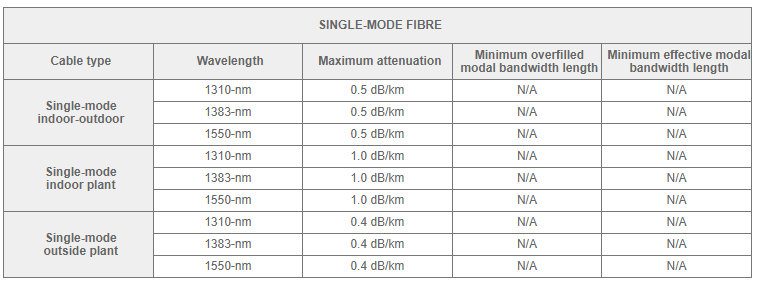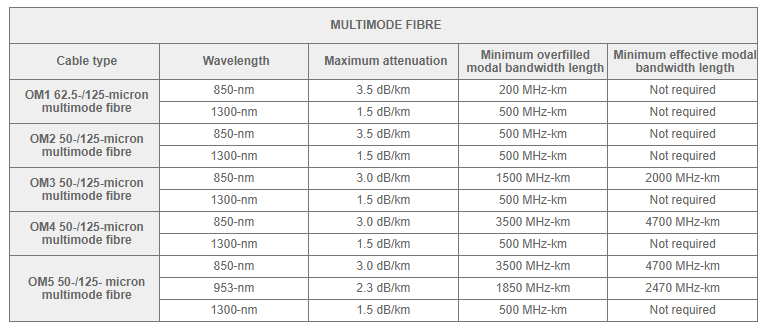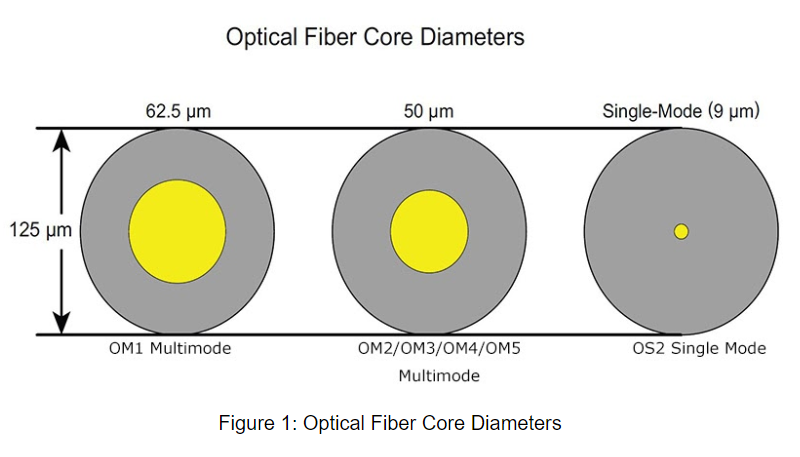Despite single mode fibre (SMF) and multimode fibre (MMF) being used in diverse applications, the difference between single mode and multimode are still confusing. With many decisions coming into play when installing fibre optic cable, by far one of the most important questions is whether to install single mode or multimode. This article will focus on the construction, fibre distance and cost in an attempt to clear the confusion between these two fibre types.
OVERVIEW; SINGLEMODE VS MULTIMODE
SINGLEMODE
Single mode as the name suggest only has one mode of propagation. A single wavelength of light in the fibre core. There is no interference or overlap between different wavelengths to scramble your data over long distances like there is in multimode.

Single mode fibre in split between to parameters: OS1 and OS2.
OS2 has a small 8-10 µm (micron) glass core, significantly smaller than multimode and any other pathway of light propagation.
OS stands for Optical Single Mode
With only one avenue of light passing through its core, single mode realigns the light towards the centre of its core instead of bouncing it edge to edge like multimode. OS1 is applied to the inner tight buffered cable, whereas OS2 is applied to Loose- tube cables.
As a rule of thumb, standard colour coding for single mode tends to be yellow for easy identification.
MULTIMODE
Multimode has a large core diameter allowing multiple modes of light to pass through it. By doing this, it allows more types of data to be transmitted.

Multimode comes in two core sizes and five sub OM varieties each defining a specific characteristic.
OM Stands for Optical Mode
- OM1 62.5 µm (micron)
- OM2 50 µm (micron)
- OM3 50 µm (micron)
- OM4 50 µm (micron)
- OM5 50 µm (micron)
Whilst all of these have the same sheath diameter, 125 µm (micron) the 50 µm (micron) Fibre optic cable has a smaller core allowing more light through.
Multimode cables rule of thumb is OM3 is typically Aqua, OM4 is Erika Violet/ Heather Violet with the latest generation of multimode fibre OM5 as lime green.
FIBRE OPTIC TRANSMISSION PERFORMANCE PARAMETER


IS MULTIMODE BETTER?
To installers new to fibre, multimode may seem more appealing because the name suggests that more can be sent over the cable. However, the multimode actually refers to multiple rays of light simultaneously taking different avenues down the core of the fibre.
WHY MULTIMODE?
The honest answer is primarily down to budget and applications. SMF requires the use of single mode transceivers and equipment and those tend to be far more expensive than multimode equivalents. The difference in price for equipment can bring single mode system costs far higher than those of multimode. Unless you’re running data over long distances we would usually recommend multimode fibre before single mode.
SUMMARY
To summarise SMF vs MMF we conclude that SMF is suitable for long reach data transmission and widely used in carrier networks and PON (Passive Optical Network). Multimode has a shorter reach but is widely used in enterprises and LAN’s. No matter what choice you make, choosing the one that best suits your networking needs is essential and you should seek advice from your network designer.

